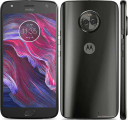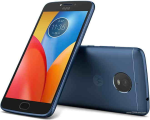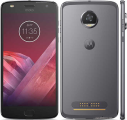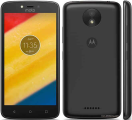Motorola Moto E (2015) Prices
Important Note.
- All prices are in Pakistani Rupee (PKR)
- Prices may vary at stores and our effort will be to provide you with the updated prices.
- The latest price of Motorola Moto E (2015) was obtained on 17 مئی, 2019. The prices at the original stores had been updated on the respective mentioned dates.
- Find out WhatMobile price has dropped in Pakistan by selecting Notify Price Drop button
- Find out WhatMobile has better specifications by clicking Add To Compare Button find out what Mobile has better reviews by visiting our reviews section
- Find out WhatMobile is cheaper on which retailer by clicking Compare prices from retailers button
Search Terms
- Motorola Moto E (2015)
Specifications
| GENERAL | |
| 2G Network | GSM 850 / 900 / 1800 / 1900 |
|---|---|
| 3G Network | HSDPA 850 / 900 / 1900 / 2100 |
| Sim | Micro-SIM |
| Announced | 01/01/2015 |
| Status | Exp. release 2015, Q1 |
| BODY | |
| DISPLAY | |
| Display Size | 4.5 inches |
| MultiTouch | Yes |
| Protection | Corning Gorilla Glass 3 |
| SOUND | |
| AlertTypes | Vibration; MP3, WAV ringtones |
| LoudSpeaker | Yes |
| 3.5mm jack | Yes |
| MEMORY | |
| CardSlot | microSD, up to 32 GB |
| Internal | 8 GB, 1 GB RAM |
| DATA | |
| GPRS | Yes |
| EDGE | Yes |
| Speed | HSPA 21.1/5.76 Mbps |
| WLAN | Wi-Fi 802.11 b/g/n, hotspot |
| Blue Tooth | v4.0, LE |
| USB | microUSB v2.0 |
| CAMERA | |
| Camera Primary | 5 MP, 2592 ? 1944 pixels, autofocus |
| Camera Features | Geo-tagging, panorama, HDR |
| CameraVideo | 720p@30fps |
| CameraSecondary | VGA |
| FEATURES | |
| Processor Cores | Single-Core |
| OS | Android OS, v5.0.2 (Lollipop) |
| CPU | Adreno 305 |
| Sensors | Accelerometer, proximity |
| Messaging | SMS(threaded view), MMS, Email, Push Email, IM |
| Browser | HTML |
| Radio | FM radio with RDS |
| GPS | Yes, with A-GPS, GLONASS |
| Java | Yes, via Java MIDP emulator |
| Colors | Black, white |
| Others | - Active noise cancellation with dedicated mic - MP3/eAAC+/WAV/Flac player - DivX/WMV/MP4/H.264 player - Photo/video editor |
| BATTERY | |
| Battery | Non-removable Li-Ion battery |
| MISC | |
Reviews

Introduction, design and display
At the back end of February this year, as I was packing my bag for MWC 2015, Motorola delivered a surprise package to TechRadar towers.
Quite like a child abandoned on an orphanage's doorstep, there was a small box waiting for us when we got to work and upon bringing it into the warmth we found it to be Motorola's own "press conference in a box."
It's a smart idea considering inside was the Motorola Moto E (2015), and heading to a full blown press conference for this would likely have been a misstep - so it being delivered directly to my palms was great.
The second generation Motorola Moto E is an upgraded version of 2014's Moto E, one of the best affordable handsets you could pick up last year.

Motorola has packed a bunch of new features into the refresh and given the design some major tweaking as well. The Moto E aims to offer the Moto G features to a fresh audience with a lower price.
In fact you can pick up the second generation Moto E for just £99.99 (around $150, AU$190) SIM free, which means it finds itself up against the EE Kestrel, Nokia Lumia 535 and Sony Xperia E3.
The design is pretty similar to what we saw on the original Moto E. It's still got a plastic body with a rounded back and all the buttons remain in the same easy to reach places, with the metal unlock and volume rocker on the right side of the phone.
The headphone jack sits in the middle at the top and the micro USB slot continues to sit in the bottom middle of the handset.
The Motorola logo is emblazoned on the back in a small indent to the body and the main camera sits above it. I always find myself placing my index finger in the Motorola logo dent, giving what feels like a little extra grip. The camera is a little larger now with a nice looking silver rim around the edge of the sensor.
The back panel is made of a softish plastic that picks up grease and dirt really quickly. It was less noticeable when playing with the white version of the handset but it showed up immediately when using the black model.
You've got the choice here of either black or white, I much prefer the white version but the black one still looks good when it's clean.
Motorola's biggest change to the design on the Moto E 2015 is the omission of the removable back panel - it's now a removable plastic edging.
When peeled away from the body it reveals the pure edges of the phone, plus ports for micro SIM and microSD cards.
It can be a real struggle getting the plastic edging off the Moto E and once I actually thought I'd broken it off. I hadn't, but it's pretty flimsy and you're easily going to get frustrated with it.
It does also mean you can replace those edges with some jazzier colour versions such as yellow and blue to give it a slightly different look but these will cost you extra directly from Motorola.
Losing the removable back panel also means the battery can't be replaced and that was a selling point of the original Moto E.
Coming round to the front of the Moto E 2015 you'll find 4.3-inch display. Above that sits a forward-facing snapper, a new addition to the Moto E, on the top right hand side next door to the long earpiece.
The phone isn't particularly thick considering the price range of the handset, but it isn't exactly slim either at 129.9 x 66.8 x 12.3 mm, while weighing in at 145g. It does fit in the hand nicely, and you can get a decent grip round the handset.
Don't expect the back of the phone to look as pristine in a couple of months' time either. I managed to be a bit of a klutz and drop it within the first day of using it and scuffed the bottom after only one drop.
I imagine dropping it a few times could do some serious damage to the outer look of the phone, so be careful out there.
Display
The 4.3-inch display on the Motorola Moto E (2015) comes with a 540 x 960 pixel resolution resulting in a pixel density of 245ppi. Don't expect a high quality affair here, you're getting what you pay for but that's not necessarily a bad thing.
Personally I feel 4.3 inches is a little too small, I feel the optimum for a smartphone is between 4.7-inch and 5.1-inch but that's all down to personal taste. That said, it's easy for your thumb to hit the top of the screen while using it one handed.
The bottom and top bezels are out of proportion here as the usual hardware buttons have been adapted into the screen this time around. It means the handset looks a little top heavy.
Video content doesn't look stunning, but it doesn't look down in the pits either and considering how little you're spending it's quite impressive.
The display is protected by Corning's Gorilla Glass 3 technology to help stiffen it up a little and after a quick drop onto paving slabs (by accident I must add) the display sustained no damage.
Putting the Moto E 2015 display onto maximum brightness was a bit of a let-down. I did that whilst outside and struggled to see the display well on a sunny day, otherwise brightness seemed pretty average and didn't really cause any problems.
If you've got poor eyesight this may not be your bag - I found myself squinting to see the display while outside, even though I've got what I consider to be 20/20 vision.
Viewing angles have never been strong on this range and once again I struggled to see some of the screen when at the wrong angle, but considering the price of the second gen Moto E you really can't complain too much.
Key features and interface
Key features
What are the key feature of the Motorola Moto E (2015) you ask? Of course the main one is the price! Motorola is offering some pretty good specs here for a phone knocking around the £100 price tag, making the Moto G look like an expensive piece of kit.
A bunch of retailers are offering the Moto E for £109 SIM-free. In this kind of category you can also get the EE Kestrel at £99, the Nokia Lumia 530 for around £89 and the Sony Xperia E3 for around £80.
The Moto E sits at least £10 higher than that but it offers quite a lot more functionality than the other competing handsets with the EE Kestrel the only one in that list also offering up 4G internet.
The Moto G is also a close competitor with an average price of around £139.99 and some interesting features. If anything the Moto G is probably the closest great competitor in price to the Moto E so be sure to read our review before making your choice of Moto.
4G LTE connectivity is a new feature for the Moto E (2014) and is a key selling point for the handset. Ultra-fast internet connectivity was missing from the original Moto E and some even accused Motorola of holding the feature back from the handset.
The software on the Moto E is the latest Android Lollipop in a stock capacity. It offers the material design the company has been teasing for so long and a selection of new features.

Considering the price of the handset the stock UI is a big benefit and offers all the functionality you'd expect to see making it a real key feature.
Interface
I've got one word for you: Lollipop. The Moto E comes running the latest and greatest Android Lollipop software in a stock capacity meaning there's no horrible overlay sat on top to hide away some of the Lollipop features.
Back in 2010 it made sense to hide away some of the Android platform with your own design overlay. But Android has developed a lot since then and the new flat UI design with Lollipop gives it a much better look than most other third-parties are offering to sit on top of it.

Along the bottom you'll find the back, home and list buttons with the stock logos representing each. The list function is in the new Lollipop style with each tab in view with a rolodex style list to scroll through and find the open app as easily as possible.
The list mode also includes the Google search bar along the top, much like it does on the homepages, where you can quickly type in to search around the phone or directly onto the internet, as well as use the Google Now voice functionality.

The keyboard is simplistic while offering a good amount of functionality. It comes with swiping technology built in as well as an intuitive dictionary bringing up better words to your attention and making typing an absolute breeze.
Along the bottom of the home page is an icon for the phone app, messages, an app drawer, Google Chrome and the calendar. The app drawer is simple and comes with all the redesigned and good looking Lollipop icons.
The lock screen now includes notifications meaning you'll be able to see the latest updates without even having to unlock the phone and swipe them away if you don't need to act on it.

The date sits across the centre with the clock taking up a good amount of the screen just above while the unlock padlock logo is in the centre of the bottom with a phone to the left and camera to the right.
If you tap on either of those logos it'll boot up the camera or phone dialler as it unlocks, which can be really helpful if you're in a bit of a hurry.
Head into your settings and you'll be able to make the phone more secure with a variety of different locks including patterns, pin numbers or passwords. There's no fingerprint sensor and the camera isn't strong enough for face recognition so you'll have to settle for an older fashioned password set up.
Performance and battery life
Performance
Under the Moto E's hood is a quad-core Qualcomm Snapdragon 410 chipset clocked at 1.2GHz. It's a set up we've seen a variety of affordable handsets over the past 12 months and it seems to be working well for almost everybody.
It's a big upgrade over the Snapdragon 200 chipset we saw in the Moto E last year and the 3G version of this year's handset.
This year's set up also includes 1GB of RAM and an Adreno 306 GPU. I ran a few tests to see how the set up handled it all. On GeekBench 3 it sent back three different scores which we took an average of to find 1421.
That's a pretty impressive set up considering some of the low scores we've seen before at the low end of the market.
The cheapest 4G phone was the EE Kestrel released last year and it still is in the same price bracket as the Moto E (2015) but only got a score of 1190 on the same test. That's quite a bit lower than the Moto E, which seems to be beating the competition quite well.
While using the handset I experienced a little bit of lag when trying to open up the camera app a few times but never really identified anything of concern.
The phone did heat up a little when playing Real Racing 3, but managed to keep up with the high frame rate of an extremely intensive game.
Battery life
The Moto E has a jacked up battery, jumping from a 1980mAh power pack on the first to a 2390mAh battery this time around. It didn't do a bad job last time around as it managed to survive the day on mixed usage, but Motorola has seen fit to increase it again.
I ran the standard 90 minute NyanGareth test video at full screen brightness from a full charge and it came out the other side with 78% charge left over. That's quite a bit of an upgrade on the original Moto E, which came out with 72% meaning if you're planning on watching a bit of video this may be a good option.

To test it even further I ran it while on a 60% brightness and found it lasted quite a bit longer coming out with 84% battery. If you're watching video just turn the brightness down a little and you'll save quite a bit of the battery.
If that isn't enough though you'll be able to save on battery with the battery saver mode that can be set up to come on at either 5% or 15% battery life.
The essentials and camera
The essentials
At this end of the market you can sometimes find some of the features you'd come to expect from smartphones are missing – the omission of 4G on the original Moto E is the perfect example. So here I'm going to head into the nitty-gritty of all the other features you'd expect to find on a smartphone.
The big addition here is the 4G connectivity. Adding in the feature is a major boost to the handset and a necessary one considering the amount of people now using 4G internet is now large and only set to keep growing.
Then there's storage – you've only got one choice when picking up the Moto E and that's a limited 8GB of storage. After you factor in space for the operating system and key apps there is only 5GB left to play with.
That means you're limited to the amount of apps, music and video you can add in on top of that. You can throw in a microSD card up to 32GB to make up for it though offering a lot more space but it's a shame Motorola hasn't upped the normal storage a little more to get in 16GB of space.
The truth is you're going to need to get a microSD unless you're happy with using your space very frugally. Even after installing what I consider to be the core apps I use every couple of days, I'd be nearing the top end of the limit and need some extra space – let alone transferring my burgeoning Spotify discography over.
I'm a stickler for keyboards and often find myself uploading a third-party offering at the earliest possible moment. The Motorola version wasn't necessary as it has Swype support built in meaning a quicker input as well as a clear and easy to use.
The Moto E (2015) takes a microSIM card and comes with all the connectivity options you'll ever going to need including Wi-FI 802.11, Bluetooth 4.0, GPS and an FM Radio thrown in for good measure.
Connectivity is now a full set of specs considering Motorola threw in the 4G LTE abilities on top of what was already there - congrats Moto.
Camera
Let's be honest, you're not buying the Moto E (2015) for a top end camera now are you? If you are you'll be a little upset when you finally get it home. There's a 5MP sensor on the rear offering 2592 x 1944 pixels with autofocus on top as well.
Considering the amount you're spending it's a pretty good set up. Taking images in good lighting caused no issues and autofocus kicked in right away when I needed it to.
The zoom had some real issues – I didn't like how grainy it got at 2x zoom even though it goes all the way up to a 4x zoom. I wouldn't want to be taking photos with the zoom at all; here's an example with my good friend Pikachu.


The lighting changes dramatically by putting it on 2x zoom and the quality goes a long way down hill.
Video recording it possible at 720p with 30fps – nothing stunning but it'll suffice when you want to take a quick little snippet of something.
A new addition here is the front facing camera. Motorola made a mistake omitting the selfie snapper on the first Moto E considering how big the narcissistic craze has become so it's added on a VGA version to take those front facing snaps in a jiffy.
Again nothing is going to blow you away here but it's enough to get a quick snap to send via Snapchat or throw onto Instagram in a hurry.
It's a shame Motorola didn't dig a little deeper and make a more impressive front facing camera but the fact it has even been added this time around is enough to pacify our complaints.
Camera samples

Click here to see the full res image

Click here to see the full res image

Click here to see the full res image
Final verdict
Motorola's new Moto E wants to sweep up the affordable smartphone market offering some pretty impressive specs for just £100 (around $150, AU$190).
The biggest selling feature of the Moto E is its super low price point offering an all round solid package with no glaring problems and a good quality set up. It's hard to think of another manufacturer offering such an impressive package all around for such a low price.
We liked
The design is exactly what you want from this kind of handset. Although not showing off a premium look it feels solid, sits well in the hand and doesn't feel like it's going to crack on the first drop. It isn't particularly bulky either while having some nice looking round corners.
Battery life is pretty solid here offering a little more than Motorola's claimed 24 hours on moderate use. I found it to last a lot longer than the HTC One Mini 2 that I use daily and it performed well in our video testing to boot.
The be all and end all is the price though – if you can name another handset as cheap as the Moto E with 4G internet, such a nice design and all the other features I will eat my metaphorical hat.
We disliked
The display has a few issues such with the brightness and viewing angles. All round it is suitable but it did pose a bit of an issue in the bright light of the outside world that should have been sorted before Motorola rolled it out officially.
Storage is an issue here with 8GB on board and a lot less to play with once the operating system is taken into account. Motorola should have adapted the amount of storage, but it has offered microSD up to 32GB to try and make it a little better than it could have been.
That front facing camera isn't anything to write home about either. It's fast becoming more used than the rear camera on many people's phones, so you'd think Motorola would put a bit more work into the front snapper but sadly there hasn't been much work here to make it jump out from other handsets.
Final verdict
The Moto E (2015) can do everything you want it to do, now there's 4G LTE connectivity you can get that superfast internet inside which is a big relief for many.
It has a solid design, sits well in the hand and feels sturdy enough to take a couple of drops.
Although it won't keep up with the flagship handsets, the new Moto E has a solid display with a good pixel density making video and anything else you're using the handset for look pretty good.
As I said before, the biggest selling point of the Moto E (2015) is the price point and you'll be hard pressed to find a more satisfactory user experience at this end of the market.
If your wallet is your main concern, be sure to jump on the Motorola boat and grab yourself the new Moto E.
First reviewed: March 2015
Write Your Own Review
My Recent Reviews
- Be first to post review for this product.
comments powered by Disqus





.jpg)






















